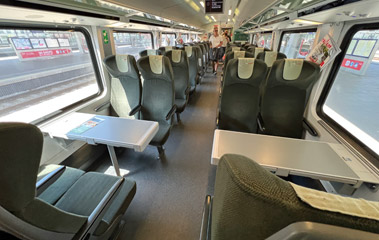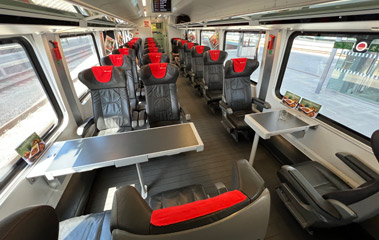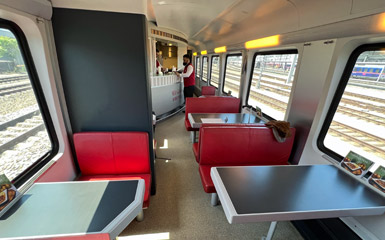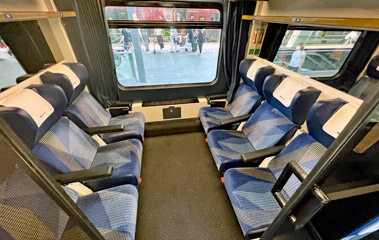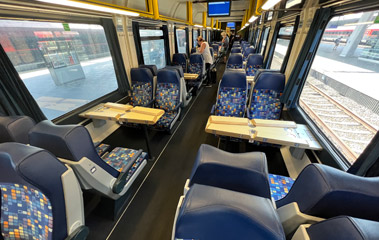|
|
Vienna to Budapest in 2h40 from €9
Comfortable railjet & EuroCity trains link Vienna Hbf with Budapest Keleti every hour taking 2h37 for the 256 km (159 miles) city centre to city centre. Railjet trains have free WiFi & draught beer on tap, plus a premium first class called business class. In 2020 these were joined by several trains a day run by competing private operator RegioJet.
![]() Option 1, by railjet or EuroCity train
from €13
Option 1, by railjet or EuroCity train
from €13
What are EuroCity & D trains like?
![]() Option 2, by
RegioJet
from €9
Option 2, by
RegioJet
from €9
What are RegioJet trains like?
Train times eastbound 2025
Train times westbound 2025
RegioJet = RegioJet train run by private open-access operator RegioJet, air-conditioned, free WiFi, power sockets, 4 classes, buy tickets at www.regiojet.com.
RJX = Railjet Train. Modern, air-conditioned, free WiFi, restaurant car, power sockets, economy, first & business classes, see photos below.
EC = EuroCity train with comfortable air-conditioned Hungarian cars, 1st & 2nd class either open-plan or in classic 6-seat compartments, see photos below.
ECD = EuroCity train with Hungarian restaurant car & air-conditioned Hungarian seats cars. Combined with Dacia Express Vienna-Bucharest sleeper train.
ECT = EuroCity train Transylvania. Air-conditioned 1st & 2nd class cars Vienna-Budapest-Cluj Napoca & Satu Mare, some Romanian, some Hungarian, restaurant car.
EN = EuroNight sleeper Kalman Imre to/from Munich & Zurich. Conveys air-conditioned Hungarian EuroCity cars Salzburg-Vienna-Budapest. No restaurant car.
Vienna to Budapest by train is 256 km or 159 miles.
Which train to choose?
-
Austrian Railways' railjets are the most modern trains. They leave every couple of hours with restaurant car, power sockets at seats, free WiFi, economy & first class plus an excellent premium 1st class called business class. Seat reservation is optional, but recommended especially in summer. More about railjets.
-
EuroCity trains are usually provided by the Hungarian Railways, using older air-conditioned carriages, most nicely modernised with bright interiors and free WiFi. Some trains have a restaurant car. More about EuroCity trains.
Austrian & Hungarian Railways operate a joint service, the railjets & EuroCity trains form an hourly service with integrated ticketing. In other words, a Standardpreis ticket can be used interchangeably on either railjet or EuroCity trains.
Seat reservation is optional for international journeys, but recommended especially in summer.
-
RegioJet is a private operator competing with the national operators. They're usually cheapest, especially at short notice when RegioJet fares remain low, but full-flex fares apply to ÖBB/MAV trains. RegioJet only run 4 trains per day, but if timings suit you their trains offer old-school comfort, free WiFi, a reserved seat included in the price, excellent at-seat service with complimentary water and Illy coffee (and a complimentary individual bottle of sparkling wine in business class). You won't regret choosing RegioJet. More about RegioJet.
Route map
Option 1, by railjet or EuroCity train
The regular trains are run jointly by Austrian & Hungarian national railways (ÖBB & MAV). Most are smart modern railjet trains provided by Austrians, some are comfortable older EuroCity trains provided by the Hungarians. One or two trains are just classified 'D' for express.
How much does it cost?
-
Cheap advance-purchase tickets
From €19.90 in 2nd class, €29.90 in 1st class or €44.90 in business class if bought from ÖBB.
From €13 in 2nd class, €27 in 1st class or €44 in business class if bought from MAV.
If you're happy to book ahead and commit to a specific train, this is what you want. Sparschiene tickets are only valid on the specific train you book, no refunds, no changes to travel plans. Prices vary, limited availability at each price level, often available even a few days in advance.
-
Flexible full-price tickets bought on the day
These cost €52.80 in 2nd class, €86.50 in 1st class or €101.50 in business class.
If you want to stay flexible or buy a ticket on the day, this is what you pay. Good for any train run by ÖBB/MAV that day including railjet, EuroCity & D trains. Unlimited availability, can't sell out.
-
Vienna Bonus - only from MAV
This costs €39 one-way in 2nd class or €59 in 1st class and has unlimited availability, it cannot sell out and can be bought at the station on the day of travel. Only available from MAV's website or MAV ticket offices, not available from ÖBB.
-
Children
Bought at www.thetrainline.com or www.oebb.at, children under 6 travel free, no ticket necessary.
Children under 15 also travel free if accompanied by an adult with an ÖBB Sparschiene fare, so booking at oebb.at can be best if you have kids.
Children under 14 get a 50% reduction on flexible fares, children under 15 get a small reduction on flexible fares (as they count as a child in Austria but not in Hungary).
Bought at www.mavcsoport.hu, children under 6 travel free, no ticket necessary. Children under 14 pay €5 between Hungary & Austria.
How to buy tickets
-
Do you need to book in advance?
Yes, if you want to save money by buying a Sparschiene fare and are happy committing to a specific train, no refunds, no changes.
No, if you are happy paying the full-price flexible fare (or, for westbound round trips, the Austria Trip Ticket fare) as these can be bought on the day of travel, they have unlimited availability and cannot sell out.
-
Option 1, buy at www.thetrainline.com
Booking opens up to 6 months ahead, less than this for dates after the mid-December timetable change.
www.thetrainline.com is the easiest website to use, it connects to the ÖBB (Austrian Railways) ticketing system to sell at ÖBB's prices and accepts overseas payment cards with no problem. A small booking fee applies, I get a some commission to support this site if you use Trainline. Trainline also connects to the German, Italian, French systems so can book trains in much of western Europe.
You can buy tickets in either direction, you print your ticket on A4 paper, U.S. Letter size is fine.
For business class, select 1st class then the business class upgrade.
Seat reservation is optional in 1st or 2nd class for a small extra charge, around €3 per seat. If you choose not to add a seat reservation you sit in any unreserved empty seat, but reserving a seat is a good idea in summer or on Friday & Sunday afternoons or if you are a family or small group who want to be sure of sitting together. But if you're a solo traveller on a Wednesday lunchtime in February, I wouldn't bother.
Business class tickets always come with a seat reservation included automatically, as do tickets for the Dacia Express & Kalman Imre which are reservation compulsory.
-
Option 2, buy from ÖBB at www.oebb.at
You can also buy from Austrian Railways' own website www.oebb.at, same prices as www.thetrainline.com, a bit more fiddly to use, although it may offer the chance to choose a seat from a seat map and there's no booking fee. You can book tickets in either direction.
-
Option 3, buy from MAV at www.mavcsoport.hu
www.mavcsoport.hu is the MAV (Hungarian Railways) website, more fiddly to use than www.thetrainline.com or www.oebb.at.
If you use MAV booking only opens 90 days ahead, less if the mid-June or mid-December timetable changes are approaching.
MAV's website is sometimes cheaper for a given train, indeed MAV's advance-purchase fares start at €13 rather than ÖBB's starting price of €19.90. See important tips for using mavcsoport.hu.
If you buy from MAV, a seat reservation is included free of charge.
Tip 1, the MAV website only sells limited-availability advance-purchase tickets and the Austria TripTicket. It cannot sell full-price flexible tickets. So when the cheap fares sell out for a given train in a given class, that train disappears from the search results. And if there are no cheap fares left on any train in the class you have selected, it says No offers available. Don't panic, see tips 2 & 3 below.
Tip 2, if you see no cheap fares on the train you want in either class, re-run the enquiry as a round trip with a return journey requested on the following day. You'll then always see the €33 Austria TripTicket 2nd class return fare and the €43 version with unlimited public transport in Vienna included. The €33 ticket is cheaper than the €40+ full-price one-way fare, so use it one-way and throw away the return half. Note: The MAV website may only list a few oddly-timed trains when you select the €33 ÖBB TripTicket ticket, in fact it is not tied to any particular train, you can take any departure you like with this ticket, whether or not shown on the website.
What are the railjets like?
The railjets are provided by ÖBB (Austrian Railways), they have 3 classes, a restaurant car, power sockets at all seats & free WiFi.
A railjet at Vienna Hbf. More about railjets. Click the photos below for larger images.
Economy class in open saloons with picture windows. Some seats around tables, most unidirectional. Note the glass-sided luggage stacks amongst the seating.
1st class with tables for 2 & 4 and unidirectional seats. Note the luggage rack in the background in the photo above right.
Business class on railjet. Just half a coach, 16 seats per train mostly arranged in 3-seat semi-compartments.
Restaurant & bar counter area. Larger photo. Food orders are taken and served at your seat in 1st & business so no need to go to the restaurant car.
The railjet has landed. A railjet has arrived spot on time on platform 9 at Budapest's historic Keleti station, built 1881-1884.
What are the EuroCity & D trains like?
EuroCity (EC) is a generic brand used by many European national railways to describe good-quality air-conditioned international express trains. On the Vienna-Budapest route EC trains usually consist of MAV (Hungarian Railways) cars built in the 1980s or 90s, most nicely modernised with free WiFi. There's usually just one first class car, sometimes with traditional 6-seat compartments (3 seats facing 3 seats opening off a side corridor), sometimes in open-plan cars with seats 1+2 across the car width. There are several 2nd class cars, usually some with 6-seat compartments and some with open-plan saloons. Although older than railjets, some people prefer their old-school comfort with more generous legroom and better alignment of seats with windows.
The Dacia Express is a sleeper train between Vienna & Romania, it conveys comfortable air-conditioned Hungarian EuroCity cars and a Hungarian restaurant car between Vienna & Budapest. It's a 'D' train in Austrian terms or 'G' in Hungarian terms, which simply means express.
The Kalman Imre is an EN EuroNight sleeper train between Zurich/Munich and Budapest, it conveys air-conditioned Hungarian EuroCity cars between Salzburg, Vienna & Budapest. It has no restaurant car.
The Transylvania is a Romanian train running between Vienna, Budapest & Cluj Napoca in Romania. It uses Romanian & Hungarian air-conditioned intercity cars.
Tip: To see photos of these trains and to check car types & composition for your specific departure, go to www.vagonweb.cz. Change cs to en upper left, then click Train formations, scroll down to Hungary and for EuroCity trains click EC, for the Dacia Express click D, for the Kalman Imre click EN. Select your train to see the train composition, click the camera icon under each carriage to see photos, the seat layout icon to see a seat plan, if available.
A EuroCity train from Vienna to Budapest in MAV's latest colour scheme at Budapest Keleti.
Option 2, by RegioJet
In 2020, private operator RegioJet started running 2 trains a day between Vienna & Budapest in competition with national rail operators ÖBB & MAV, increased to 4 per day in 2024. RegioJet is a Czech travel company, part of Student Agency which operates long distance bus services in the Czech Republic. Three of these Vienna-Budapest trains have been created by extending RegioJet's successful Prague-Vienna trains to Budapest. With air-conditioning, free WiFi, power sockets, and 4 classes, RegioJet is a good choice. There's no restaurant car, but there's at-seat service in Standard, Relax & Business classes with complimentary water & Illy coffee. All tickets come with a specific reserved seat. Watch the RegioJet video.
How much does it cost?
-
Vienna to Budapest starts at €9 in Low cost, €11.90 in Standard, €13.90 in Relax, €15.90 in Business class.
Unlike ÖBB's fares, prices only increase a little as departure approaches or on busy dates or trains, for example as I write this, Standard class on this afternoon's train is only €15.90, Business class only €21.90, making RegioJet inexpensive even at short notice.
Tickets are only good for the specific train you book, but are refundable and can be cancelled or changed in their app up to 15 minutes before departure. Cheap and flexible!
-
Children under 6 free, children under 15 go at the child rate.
-
If you have an ISIC student card you get a 10% discount in Standard & Relax classes on RegioJet trains, but not in Business class.
How to buy tickets
-
Buy tickets at www.regiojet.com.
Booking opens several months ahead, but there's no need to book more than a few weeks ahead, days ahead is fine, in fact there are almost always seats available at cheap fares even on the day of travel.
All tickets come with a reserved seat, you can select from a seat map when booking at www.regiojet.com. So in theory tickets can sell out, in practice you'd be very unlucky not to find places available on the day, you can buy in their app up to 15 minutes before departure.
Tip: When booking, type Buda... and select Budapest - Deli pu. not the generic Budapest, Hungary. If you use the generic Budapest, Hungary it assumes you want the out-of-centre Budapest Kelenfold, you want Budapest Deli as that is one of the city's central termini.
You print your own ticket or can show it on your laptop, tablet or phone.
You probably won't need to show it: There's no check-in, no ticket check, just free & open access from street to train, board up to 1 minute before departure. Once on board, conductors have a seat map on their tablets and know which seats are paid for, so don't need to disturb you.
-
At Prague Hlavni, RegioJet (Student Agency) has its own ticket office at the main entrance level.
-
Interrail & Eurail passes are now valid on RegioJet, €3 reservation fee in Standard, €5 in Relax, or (with a 1st class pass) €10 in Business.
What are RegioJet trains like?
-
RegioJet trains have 4 classes: Low cost, Standard, Relax & Business. All tickets include a specific reserved seat.
-
Low cost class
Low cost has basic air-conditioned seating and that's about all. Comfortable enough, but unlike all other classes there's no free water or coffee, in fact there is no catering of any sort, so bring your own food & drink.
The Man in Seat 61 says: Low cost is fine for short hops, but for longer journeys such as Prague to Vienna I recommend paying a little more to travel in standard class - the free water & coffee in standard class justifies the extra few euros!
-
Standard class
Standard class comes in two varieties, regular and Astra. Regular standard class consists of seats in comfortable classic 6-seater compartments in former Austrian Railways intercity cars with power sockets, but usually no WiFi, see 360ş photo.
Standard class Astra consists of open-plan seating in a positively glitzy open-plan car with leather seats, drop-down tables, power sockets, free WiFi and seat-back entertainment touch screens, see 360ş photo. Seats in the Astra coach are arranged 2+2 across the car width. Incidentally, Astra is the name of the Romanian rolling stock manufacturer who modernised these cars.
In standard class you get complimentary Italian Illy coffee (Espresso, Lungo, Latte Macchiato, Cappuccino) & bottled water, newspapers and magazines. You can order wine, beer, snacks and even sushi at remarkably cheap prices from staff. If you have kids, you can book seats in the children's compartment.
-
Relax class
Relax class offers leather seats in a spacious 1st class arrangement 2+1 across the car width, carpeted and air-conditioned with free WiFi and power sockets at each seat. They're usually former Austrian Railways intercity cars. There is complimentary Italian Illy coffee (Espresso, Lungo, Latte Macchiato, Cappuccino), mint tea & bottled water, newspapers and magazines. You can order wine, beer, snacks and even sushi at remarkably cheap prices from staff. One carriage attendant serves every two cars. See 360° photo.
-
Business class
In Business class you get leather seats in spacious 4 seat compartments. These are usually former Austrian Railways intercity cars, carpeted and air-conditioned with free WiFi and power sockets at each seat. There is complimentary Italian Illy coffee (Espresso, Lungo, Latte Macchiato, Cappuccino), Oxalis or mint tea, sparkling wine, orange juice & bottled water, newspapers and magazines. You can order wine, beer, snacks and even sushi at remarkably cheap prices from the staff. One carriage attendant serves every two cars. See 360° photo.
The Man in Seat 61 says, "I had a 4-seat business class compartment to myself on what was otherwise a very busy train. Staff were friendly and regularly popped their head around the door to ask if I needed anything from the menu. The complimentary Illy coffee was of course excellent (I'm a fan of Illy coffee) as was the complimentary Czech sparkling wine. Lunch was a tasty sushi set for only €3. Sushi on a train, who thought of that? Genius! A great journey, I can easily recommend RegioJet!"
-
You can see each train's composition at www.vagonweb.cz - select en top left for English, click Train formations, scroll down to the relevant country & look for RJ RegioJet.
A RegioJet train at Vienna Hbf.
Standard class Astra car. Larger photo. 360° photo.
Travel tips
-
Which station in Vienna?
Vienna Hbf is Vienna's main station, close to the city centre, the best station to use. Many trains (but not all) also serve Vienna Meidling, by all means get on or off there if it's nearer your hotel. International trains no longer use Vienna Westbahnhof.
-
Which station Budapest?
The ÖBB/MAV railjet & EuroCity trains use Budapest Keleti in the city centre, a historic station with good onward connections. RegioJet trains use Budapest Deli, also in the city centre although a less attractive concrete station with a 1970s vibe.
All trains call at Budapest Kelenföld on their way to or from downtown Budapest, but Kelenföld is outside the city centre so I wouldn't plan to get on or off here. There's one good reason to use Kelenföld : If you're heading from Vienna to Lake Balaton, an easy same-station change at Kelenföld saves you going into Budapest Keleti then taking a taxi or metro to Budapest Deli for a train back through Kelenfold to Balaton.
-
Which is better, ÖBB/MAV or RegioJet? See my advice above.
-
Which of the ÖBB/MAV trains is better, railjet or EuroCity?
Railjet trains are Austrian Railway's flagship train with restaurant car, free WiFi, power sockets at all seats. Business & first class passengers have food & drink orders taken and served at their seat, no need to go to the restaurant car. All seating in Railjets is open-plan. They are swisher, more modern and have better facilities than the EuroCity trains.
EuroCity trains offer more conventional old-school comfort, using air-conditioned Hungarian Railways (MAV) cars hauled by a separate locomotive, most now smartly modernised. There may be more legroom in old-school 2nd class EuroCity cars compared to the modern railjets, the modernised cars have power sockets & WiFi, the occasional unmodernised car may still lack these. EuroCity trains usually have a mixture of open-plan cars and classic old-school 6-seater compartments. Some EuroCity trains have a proper restaurant car, some now only have a refreshment trolley.
The EuroNight Kalman Imre/Wiener Walzer is also fine, with Hungarian EuroCity cars between Vienna & Budapest, but no restaurant car. The Dacia Express conveys Hungarian EuroCity cars between Vienna & Budapest and a Hungarian restaurant car.
-
Which class to choose on railjets & EuroCity trains?
Economy (on railjets) or 2nd class (on EuroCity trains) is absolutely fine, there's no need to go 1st class unless you don't mind the extra cost. But see what prices you get because sometimes 1st class doesn't cost much more than 2nd. 2nd class seats are arranged 2+2 across the car width, mostly unidirectional but with a few tables-for-four which are ideal for families.
First class gets you more leg & elbow room, with (on railjets) leather seats arranged 2+1 across the car width rather than 2+2 as in economy. So on one side of the aisle you'll find solo seats ideal if you're travelling alone, and a few face-to-face tables-for-two ideal for couples. Food & drink are not included, but on railjets orders are taken & served at your seat so you don't need to visit the restaurant car.
Business class is the top class, only available on railjets, it consists of 16 very comfortable leather cradle seats in several semi-compartments, see the Austrian railjet page. Business class costs €15 on top of any 1st class ticket or railpass, this also gets you a reserved seat. You get a complimentary welcome drink - perhaps sparking wine - and a small snack. Food is not included, but food orders from the restaurant car menu are taken by the steward and delivered to your seat. Business class is an extravagance, but a treat I'm rather partial to!
The trains are all non-smoking like most European trains, and on Railjets there are wheelchair spaces & accessible toilets.
-
Which class to choose on RegioJet? See the RegioJet section.
-
Seat maps & train composition
See railjet seat map. The layout of EuroCity & RegioJet carriages varies so much there's no generic seat map.
You can check the composition of any specific Vienna-Budapest train with photos of each type of carriage and it's facilities at www.vagonweb.cz. Select en top left for English, click Train formations, scroll down to the relevant country & look for your train type, RJX Railjet, EC EuroCity or RJ RegioJet. You may find a seat map for some EuroCity carriages here, click the seat map logo if it appear below the relevant carriage.
-
If you already have a ticket or Eurail/Interrail pass & want a seat reservation:
You can make a reservation-only booking for the regular ÖBB/MAV railjet, EuroCity or D trains at www.oebb.at. Simply tick the Seat reservation only box before running the enquiry.
Reservation isn't compulsory, so if you like you can just board the train, find any empty unreserved seat and show your pass when the conductor comes round.
RegioJet also accepts Interrail & Eurail passes, but reservations cannot be made online. So either approach RegioJet staff on the platform when the train arrives for boarding, or (in Vienna) make a reservation at the RegioJet ticket office at Vienna Hbf.
-
Luggage
You can pretty much take anything you like as long as you can carry it or pull it behind you. Nobody will weigh or measure it! You take it with you onto the train, there's plenty of luggage space in both classes, the racks above your seat take anything up to backpack-size, there are racks for larger suitcases at the car ends and in amongst the seats. More about luggage on European trains.
-
First class lounges in Vienna & Budapest
First & business class passengers on the regular ÖBB/MAV trains can use the excellent ÖBB lounge at Vienna Hbf with complimentary tea, coffee, juice, snacks & free WiFi. There is also an excellent MAV first class lounge at Budapest Keleti. RegioJet has no lounges.
-
Boarding your train
As with almost all European trains, there's no check-in and in Austria and Hungary, no ticket check. Just stroll into the station, find your train and get on, any time before it leaves. The doors may close a minute before departure.
-
Free WiFi, Power sockets & toilets
Railjet & RegioJet trains have free WiFi in all classes, and power sockets at all seats in all classes. EuroCity & D trains may not have WiFi (although many Hungarian EuroCity cars have it), the various types of car may or may not have power sockets. Every car on all these trains has at least one toilet.
-
Bicycles: Bicycles can be taken on railjets, but bike spaces are limited and must be booked in advance at the station.
-
Children's TV screen. On railjets there's a small children's play area with a TV showing cartoons at one end of car 21.
-
Map of Vienna showing Vienna Hbf - Map of Budapest showing Keleti station..
What's the journey like?
Between Vienna & Budapest it's largely flat, with more wind-turbines than you've ever seen - allegedly over 200. A journey across two countries is always an insight, but in this case the photo below largely sums up the whole route! Just before arriving in Budapest eastbound (or just after leaving Budapest, westbound) the train crosses the wide river Danube, although a modern road bridge now obscures the view of the city along the river. The trains normally keep pretty good time, so expect an on-time arrival into Budapest's historic Keleti station, built 1881-1884.






